Spatial Distribution Characteristics of the Rural Tourism Villages in the Qinghai-Tibetan Plateau and Its Influencing Factors
Abstract
:1. Introduction
2. Materials and Methods
2.1. Study Area
2.2. Data Source and Processing
2.3. Research Method
2.3.1. Nearest Neighbor Index
2.3.2. Geographic Concentration Index
2.3.3. Global Moran’s I
2.3.4. Geits-Ord
2.3.5. Kernel Density Estimation
2.3.6. Geodetector
3. Results Analysis
3.1. Spatial Distribution Characteristics
3.2. Influencing Factors
3.2.1. Topographic
3.2.2. Climate
3.2.3. Hydrology
3.2.4. Traffic Condition
3.2.5. Socio-Economic
3.2.6. Tourism Resource
3.3. Driving Mechanism
4. Discussion
4.1. Comparison of the Results of Related Studies
4.2. How to Develop RT Villages in QTP
- (1)
- Improving regional RT village structures and promoting coordinated regional development. The current spatial distribution of RT villages which are spatially concentrated and highly centralized represents the choice of the tourism market. However, this will hinder the balanced and sustainable development of the RT industry in the long term. Some areas will be overdeveloped and lead to relatively fierce competition in the later stages, and some areas will result in the decay of existing RT resources through disuse. To avoid or reduce this phenomenon, the government should play a greater role to ensure more balanced and coordinated development. Huangshui Valley as the most densely distributed area of RT villages, should unleash the agglomeration effect and spillover effect, and focus on the improvement of tourism quality and guiding the market to reduce unnecessary repetitive construction. YNL River region as a relatively un-dense distribution area should scale up financial support to exploit more tourism resources and increase policy support for inscribing on various RT villages lists.
- (2)
- Strengthen ecological and environmental protection. The special geological, topographic, and weather conditions on the QTP make its ecosystem fragile and highly vulnerable to environmental changes [60]. Moreover, the ecological environment of QTP is important to the sustainable development of East Asia and the whole world. So, it is important to protect the ecological environment of the QTP. Tourism will affect heavily the environment of QTP if not properly managed. Along the needs for transport, food and accommodation will exert enormous stress on the ecology of QTP. Therefore, it should coordinate the relationship between RT development and environmental protection, take the natural ecological environment of the village as an important attraction for RT development, and create a green and livable RT destination. To achieve this, first, the size of RT villages and the number of tourists should depend on the tourism environment carrying capacity of the village. Second, any tourism-related infrastructure in the village must be environmentally sustainable. Finally, governments need to increase efforts to raise environmental protection awareness of local villagers and tourists.
- (3)
- Supporting the integration of culture and tourism. The sense of the holy land, the feeling of purity, and the mysterious atmosphere of religion distinguish QTP rural areas from the cultural atmosphere in other regions. The cultural resources of the QTP include ethnic cultural resources, mainly Tibetan, Han, Qiang, Hui, and other ethnicities, and religious cultural resources, mainly Tibetan Buddhism, Islam and Taoism, and folk culture resources, mainly costumes, catering, etiquette, and festivals, digging into the cultural connotation and preserving, inheriting, and promoting the culture of QTP. First, adhering to the principle of combining conservation and development of culture. The cultural differences between tourists and villagers will cause a huge impact on the villagers. It is important to assess scientifically, protect primarily, and develop appropriately, so that the rich and colorful cultural resources of the QTP can be developed sustainably. Second, highlighting the different regional characteristics and features of the culture, showing the diversity of QTP cultural resources. Generally, QTP can be divided into frontal Tibet, interior Tibet, An Tibet, and Kang Tibet. The culture differs significantly from region to region. The development of cultural resources in each region should complement and be independent of each other. Last, encouraging community involvement. Villagers are both creators and owners of culture. The participation of the local community is not only conducive to increasing the income, but also to maintaining the original local character.
- (4)
- Taking the active steps to respond to climate change. QTP shows a large-scale warming trend of 0.3 °C per decade since the mid-1950s, which is significantly three times faster than the global warming rate. Climate change has caused glacier retreat, snow cover change, and permafrost degradation of QTP [61], and may have implications for wetland-based tourism, ski-based tourism, glacier-based tourism, plant-based tourism, and wildlife-based tourism of QTP [62]. Climate change is a real threat to many rural regions which affects the RT offerings. As Arunima Karali suggested, climate change should incorporate in the context of sustainable RT because dealing with climate change issues has been a prerequisite in the sustainable tourism research. Therefore, we should consider RT strategy and management to try to mitigate climate change challenges and support rural community resilience. First, the government should establish a climate monitoring and early warning platform, (i) providing severe weather forecasting; (ii) providing tourism climate comfort relate information; (iii) providing phenology relate data, guiding flower-viewing rural tourism and picking rural tourism. Second, the government should conduct awareness and education to improve the perception of climate change risks of all stakeholders. Encouraging visitors to adopt “climate-friendly” consumption habits, such as consuming local food instead of foreign food, and reducing their carbon footprint. Providing publicity on scientific knowledge related to coping with extreme weather to local villagers, to enhance awareness of disaster resilience and response.
4.3. Limitations of the Study
5. Conclusions
- The overall spatial distribution of RT villages in the QTP is dense in the southeast and sparse in the northwest, taking Qilian-Jilong Line as the boundary. The nearest neighbor index is 0.39, indicating that RT villages show aggregated distribution character. The uneven spatial distribution of RT villages is significant at the inter-county level, in which the geographic concentration index is 13.3%, and the Lorentz curve presents a typical concave form. Regarding spatial pattern, RT villages have formed four relatively dense distribution areas, namely the Huangshui Valley, West Sichuan Mountain, Northwest Yunnan and YNL River region. RT villages in QTP have a positive spatial autocorrelation (Moran’s I = 0.268), and 59.1% of the area belongs to cold spots and 2.13% of the area belongs to hot spots based on the cluster of correlation.
- The analysis of topographic factors revealed that medium altitude, low slope, and moderate fluctuation had become the main areas for the distribution of RT villages. Regarding climate factors, 84% of RT villages have an annual temperature greater than 6 °C, and 58% of the RT villages have an oxygen content greater than 220 g/m3. In terms of hydrology, the spatial distribution of RT villages shows hydrophilic characteristics, 45% of RT villages located within 10 km from rivers or lakes, and the number of RT villages decreasing with the increased distance from the rivers or lakes. From the perspective of traffic condition, 65% of the RT villages are accessible by road within 10 km, with the most accessible by provincial road and the least accessible by highway. Moreover, 58% of RT villages are located within 100 km of central cities. Concerning the distribution of socio-economic factor, the population size has a medium correlation with the RT villages (r = 0.33), and the level of economic has a small correlation with the RT villages (r = 0.14). As for tourism resource, the spatial distribution of RT villages is positively related to the layout of scenic spot (r = 0.31) and culture heritage (r = 0.22).
- The spatial distribution of RT villages is the result of multifactor interactions. From the single driving factor, the factor with the strongest explanatory power is population size (0.333) > scenic spot (0.332) > oxygen content (0.242) > major cities (0.237) > culture heritage (0.237). In terms of the composite factor interaction results, the explanatory power of the interaction is better than the single factor, the interaction network formed by tourism resource and socio economic strongly determines the spatial distribution pattern of the RT villages.
Author Contributions
Funding
Institutional Review Board Statement
Informed Consent Statement
Data Availability Statement
Conflicts of Interest
References
- World Travel and Tourism Council: Global Economic Impact & Trends 2021. Available online: https://wttc.org/Research/Economic-Impact (accessed on 15 June 2022).
- UN Report Underscores Importance of Tourism for Economic Recovery in 2022. Available online: https://www.unwto.org/news/un-report-underscores-importance-of-tourism-for-economic-recovery-in-2022 (accessed on 15 June 2022).
- Li, Z.; Zhang, X.; Yang, K.; Singer, R.; Cui, R. Urban and rural tourism under COVID-19 in China: Research on the recovery measures and tourism development. Tour. Rev. 2021, 76, 718–736. [Google Scholar] [CrossRef]
- Lane, B. What is rural tourism? J. Sustain. Tour. 1994, 2, 7–21. [Google Scholar] [CrossRef]
- Putu, D.R.; Dupre, K.; Ying, W. Rural tourism: A systematic literature review on definitions and challenges. J. Hosp. Tour. Manag. 2021, 47, 134–149. [Google Scholar] [CrossRef]
- Helgadottir, G.; Dashper, K. 20 years of Nordic rural tourism research: A review and future research agenda. Scand. J. Hosp. Tour. 2021, 21, 60–69. [Google Scholar] [CrossRef]
- Cawley, M.; Gillmor, D.A. Integrated rural tourism. Ann. Tour. Res. 2008, 35, 316–337. [Google Scholar] [CrossRef]
- He, Y.; Wang, J.; Gao, X.; Wang, Y.; Choi, B.R. Rural Tourism: Does It Matter for Sustainable Farmers’ Income? Sustainability 2021, 13, 10440. [Google Scholar] [CrossRef]
- Wang, R.; Dai, M.; Ou, Y.; Ma, X. Residents’ happiness of life in rural tourism development. J. Destin. Mark. Manag. 2021, 20, 100612. [Google Scholar] [CrossRef]
- López-Sanz, J.M.; Penelas-Leguía, A.; Gutiérrez-Rodríguez, P.; Cuesta-Valiño, P. Sustainable Development and Rural Tourism in Depopulated Areas. Land 2021, 10, 985. [Google Scholar] [CrossRef]
- He, Y.; Gao, X.; Wu, R.; Wang, Y.; Choi, B.-R. How Does Sustainable Rural Tourism Cause Rural Community Development? Sustainability 2021, 13, 13516. [Google Scholar] [CrossRef]
- Barke, M. Rural tourism in Spain. Int. J. Tour. Res. 2004, 6, 137–149. [Google Scholar] [CrossRef]
- Gartner, W.C. Rural tourism development in the USA. Int. J. Tour. Res. 2004, 6, 151–164. [Google Scholar] [CrossRef]
- Koscak, M. Integral development of rural areas, tourism and village renovation, Trebnje, Slovenia. Tour. Manag. 1998, 19, 81–85. [Google Scholar] [CrossRef]
- Ghaderi, Z.; Henderson, J.C. Sustainable rural tourism in Iran: A perspective from Hawraman Village. Tour. Manag. Perspect. 2012, 2, 47–54. [Google Scholar] [CrossRef]
- Wang, L.-E.; Cheng, S.-K.; Zhong, L.-S.; Mu, S.-L.; Dhruba, B.G.C.; Ren, G.-Z. Rural tourism development in China: Principles, models and the future. J. Mt. Sci. 2013, 10, 116–129. [Google Scholar] [CrossRef] [Green Version]
- Yin, X.; Chen, J.; Li, J. Rural innovation system: Revitalize the countryside for a sustainable development. J. Rural Stud. 2019, 93, 471–478. [Google Scholar] [CrossRef]
- Yang, J.; Yang, R.; Chen, M.-H.; Su, C.-H.; Zhi, Y.; Xi, J. Effects of rural revitalization on rural tourism. J. Hosp. Tour. Manag. 2021, 47, 35–45. [Google Scholar] [CrossRef]
- Jia, Z.; Jiao, Y.; Zhang, W.; Chen, Z. Rural Tourism Competitiveness and Development Mode, a Case Study from Chinese Township Scale Using Integrated Multi-Source Data. Sustainability 2022, 14, 4147. [Google Scholar] [CrossRef]
- Karali, A.; Das, S.; Roy, H. Forty years of the rural tourism research: Reviewing the trend, pattern and future agenda. Tour. Recreat. Res. 2021, 46, 1–28. [Google Scholar] [CrossRef]
- Lane, B.; Kastenholz, E. Rural tourism: The evolution of practice and research approaches—Towards a new generation concept? J. Sustain. Tour. 2015, 23, 1133–1156. [Google Scholar] [CrossRef]
- Wenchang, W. Rural Management–The Way Out for Tibetan Rural Areas. Bus. Public Adm. Stud. 2008, 3, 75. [Google Scholar]
- Lihua, L.; Jingming, H. Sustainable rural tourism and its implications for poverty alleviation in Tibet autonomous region, PR China. Poverty Alleviation Mt. Areas China 2002, 12, 209–220. [Google Scholar]
- Senyao, S.; Ha, S. How social media influences resident participation in rural tourism development: A case study of Tunda in Tibet. J. Tour. Cult. Chang. 2022, 20, 386–405. [Google Scholar] [CrossRef]
- Lun, Y.; Jing, S.; Moucheng, L.; Qingwen, M. Agricultural production under rural tourism on the Qinghai-Tibet Plateau: From the perspective of smallholder farmers. Land Use Policy 2021, 103, 105329. [Google Scholar] [CrossRef]
- Saayman, M.; Du Plessis, E. Competitiveness of South Africa as a tourist destination. S. Afr. J. Res. Sport Phys. Educ. Recreat. 2003, 25, 57–65. [Google Scholar] [CrossRef]
- Zhu, J.; Jian, F. Spatial Pattern Evaluation of Rural Tourism via the Multifactor-Weighted Neural Network Model in the Big Data Era. Comput. Intell. Neurosci. 2021, 2021, 1–12. [Google Scholar] [CrossRef] [PubMed]
- Wang, X.; Li, X. Characteristics and influencing factors of the key villages of rural tourism in China. Acta Geogr. Sin. 2022, 77, 900–917. [Google Scholar]
- Zhan, Z.; Cenci, J.; Zhang, J. Frontier of Rural Revitalization in China: A Spatial Analysis of National Rural Tourist Towns. Land 2022, 11, 812. [Google Scholar] [CrossRef]
- Mostafa, M.M.H.; Lei, J.; Liu, Y.; Manickam, S. The spatial distribution characteristics, influencing factors and development models of rural tourism in China. E3S Web Conf. 2021, 261, 03022. [Google Scholar] [CrossRef]
- Xu, J.; Yang, M.S.; Hou, C.P.; Lu, Z.L.; Liu, D. Distribution of rural tourism development in geographical space: A case study of 323 traditional villages in Shaanxi, China. Eur. J. Remote Sens. 2021, 54, 318–333. [Google Scholar] [CrossRef]
- Tao, Z.; Fengxuan, L.; Yongwu, X. Spatial Distribution Characteristics and Development Path of Rural Tourism Areas in Liaoning Province. Areal Res. Dev. 2021, 40, 75–79. [Google Scholar]
- Shikun, S.; Chunyun, S.; Dayuan, Z.; Yanyu, Z.; Qiao, J. Research on the spatial distribution of rural tourist attractions in Jiangsu Province and its influencing factors. J. Chin. Ecotour. 2021, 11, 455–467. [Google Scholar]
- Ruilin, Y.; Huiyuan, C.; Guangping, C.; Chengliang, L. Spatial Distribution of Rural Tourism Destination and Influencing Factors in Hubei Province—A Case Study of High-Star Agritainment. Econ. Geogr. 2018, 38, 210–217. [Google Scholar]
- Shen, S.; Wang, H.; Quan, Q.; Xu, J. Rurality and rural tourism development in China. Tour. Manag. Perspect. 2019, 30, 98–106. [Google Scholar] [CrossRef]
- Liu, C.; Dou, X.; Li, J.; Cai, L.A. Analyzing government role in rural tourism development: An empirical investigation from China. J. Rural Stud. 2020, 79, 177–188. [Google Scholar] [CrossRef]
- Barkauskas, V.; Barkauskienė, K.; Jasinskas, E. Analysis of macro environmental factors influencing the development of rural tourism: Lithuanian case. Procedia Soc. Behav. Sci. 2015, 213, 167–172. [Google Scholar] [CrossRef] [Green Version]
- Wilson, S.; Fesenmaier, D.R.; Fesenmaier, J.; Es, J.C.V. Factors for Success in Rural Tourism Development. J. Travel Res. 2016, 40, 132–138. [Google Scholar] [CrossRef]
- An, W.; Alarcon, S. Rural tourism preferences in Spain: Best-worst choices. Ann. Tour. Res. 2021, 89, 103210. [Google Scholar] [CrossRef]
- Miller, G. The development of indicators for sustainable tourism: Results of a Delphi survey of tourism researchers. Tour. Manag. 2001, 22, 351–362. [Google Scholar] [CrossRef] [Green Version]
- Lee, B.C.; Kim, D.-K. Relative importance to tourism decision makers of indicators for sustainable rural tourism development in South Korea: Using AHP approach. J. Tour. 2009, 10, 21–43. [Google Scholar]
- Streimikiene, D.; Bilan, Y. Review of rural tourism development theories. Transform. Bus. Econ. 2015, 14, 21–34. [Google Scholar]
- Ruan, W.; Li, Y.; Zhang, S.; Liu, C.-H. Evaluation and drive mechanism of tourism ecological security based on the DPSIR-DEA model. Tour. Manag. 2019, 75, 609–625. [Google Scholar] [CrossRef]
- Ma, X.; Yang, Z.; Zheng, J. Analysis of spatial patterns and driving factors of provincial tourism demand in China. Sci. Rep. 2022, 12, 1–15. [Google Scholar] [CrossRef]
- Tang, W.; Zhou, T.; Sun, J.; Li, Y.; Li, W. Accelerated urban expansion in lhasa city and the implications for sustainable development in a Plateau City. Sustainability 2017, 9, 1499. [Google Scholar] [CrossRef] [Green Version]
- Jarvis, A.; Reuter, H.I.; Nelson, A.; Guevara, E. Hole-Filled SRTM for the globe Version 4, Available from the CGIAR-CSI SRTM 90m Database. Available online: https://srtm.csi.cgiar.org (accessed on 15 June 2022).
- Illian, J.; Penttinen, A.; Stoyan, H.; Stoyan, D. Statistical Analysis and Modelling of Spatial Point Patterns; John Wiley & Sons: Hoboken, NJ, USA, 2008; Volume 70. [Google Scholar]
- Moran, P.A. Notes on continuous stochastic phenomena. Biometrika 1950, 37, 17–23. [Google Scholar] [CrossRef]
- Getis, A.; Ord, J.K. The Analysis of Spatial Association by Use of Distance Statistics. In Perspectives on Spatial Data Analysis; Springer: Berlin/Heidelberg, Germany, 2010; pp. 127–145. [Google Scholar]
- Wang, J.; Li, X.; Christakos, G.; Liao, Y.; Zhang, T.; Gu, X.; Zheng, X. Geographical detectors-based health risk assessment and its application in the neural tube defects study of the Heshun Region, China. Int. J. Geogr. Inf. Sci. 2010, 24, 107–127. [Google Scholar] [CrossRef]
- Gao, X.; Li, T.; Sun, D. Regional Differentiation Regularity and Influencing Factors of Population Change in the Qinghai-Tibet Plateau, China. Chin. Geogr. Sci. 2021, 31, 888–899. [Google Scholar] [CrossRef]
- Fang, C.; Liu, H.; Luo, K.; Yu, X. Comprehensive regionalization of human geography in China. Acta Geogr. Sin. 2017, 72, 179–196. [Google Scholar]
- Jia, X.; Li, F.; Cui, M.; Cheng, G.; Zhao, Y.; Ding, H.; Yu, B.; Lu, H. Differentiations of geographic distribution and subsistence strategies between Tibetan and other major ethnic groups are determined by the physical environment in Hehuang Valley. Acta Geogr. Sin. 2019, 49, 706–716. [Google Scholar] [CrossRef]
- La, M. Exploring strategic paths for the integrated development of culture and tourism in ethnic areas of the Western Sichuan Plateau. J. Southwest Minzu Univ. 2011, 32, 137–140. [Google Scholar]
- Llamas, R.; Belk, R. Shangri-La: Messing with a myth. J. Macromark. 2011, 31, 257–275. [Google Scholar] [CrossRef]
- Wang, L.; Guo, J.; Feng, L.; Luo, Y.; Zhang, X.; Fan, Y.; Cheng, S. The structure and characteristics of resident food consumption in rural areas of the Tibetan Plateau: Taking Three-Rivers Region in Tibet as an example. Acta Geogr. Sin. 2021, 76, 2104–2117. [Google Scholar]
- Feng, Z.; Li, W.; Li, P.; Xiao, C. Relief degree of land surface and its geographical meanings in the Qinghai-Tibet Plateau, China. Acta Geogr. Sin. 2020, 75, 1359–1372. [Google Scholar]
- Tang, C.; Zhong, L.; Kristen, M.; Cheng, S. A comprehensive evaluation of tourism climate suitability in Qinghai Province, China. J. Mt. Sci. 2012, 9, 403–413. [Google Scholar] [CrossRef]
- Song, Y.; Wang, J.; Ge, Y.; Xu, C. An optimal parameters-based geographical detector model enhances geographic characteristics of explanatory variables for spatial heterogeneity analysis: Cases with different types of spatial data. GISci. Remote Sens. 2020, 57, 593–610. [Google Scholar] [CrossRef]
- Liu, J.; Milne, R.I.; Cadotte, M.W.; Wu, Z.-Y.; Provan, J.; Zhu, G.-F.; Gao, L.-M.; Li, D.-Z. Protect Third Pole’s fragile ecosystem. Science 2018, 362, 1368. [Google Scholar] [CrossRef]
- Yao, T.; Thompson, L.G.; Mosbrugger, V.; Zhang, F.; Ma, Y.; Luo, T.; Xu, B.; Yang, X.; Joswiak, D.R.; Wang, W. Third pole environment (TPE). Environ. Dev. 2012, 3, 52–64. [Google Scholar] [CrossRef]
- Wang, L.; Zeng, Y.; Zhong, L. Impact of climate change on tourism on the Qinghai-Tibetan Plateau: Research based on a literature review. Sustainability 2017, 9, 1539. [Google Scholar] [CrossRef] [Green Version]
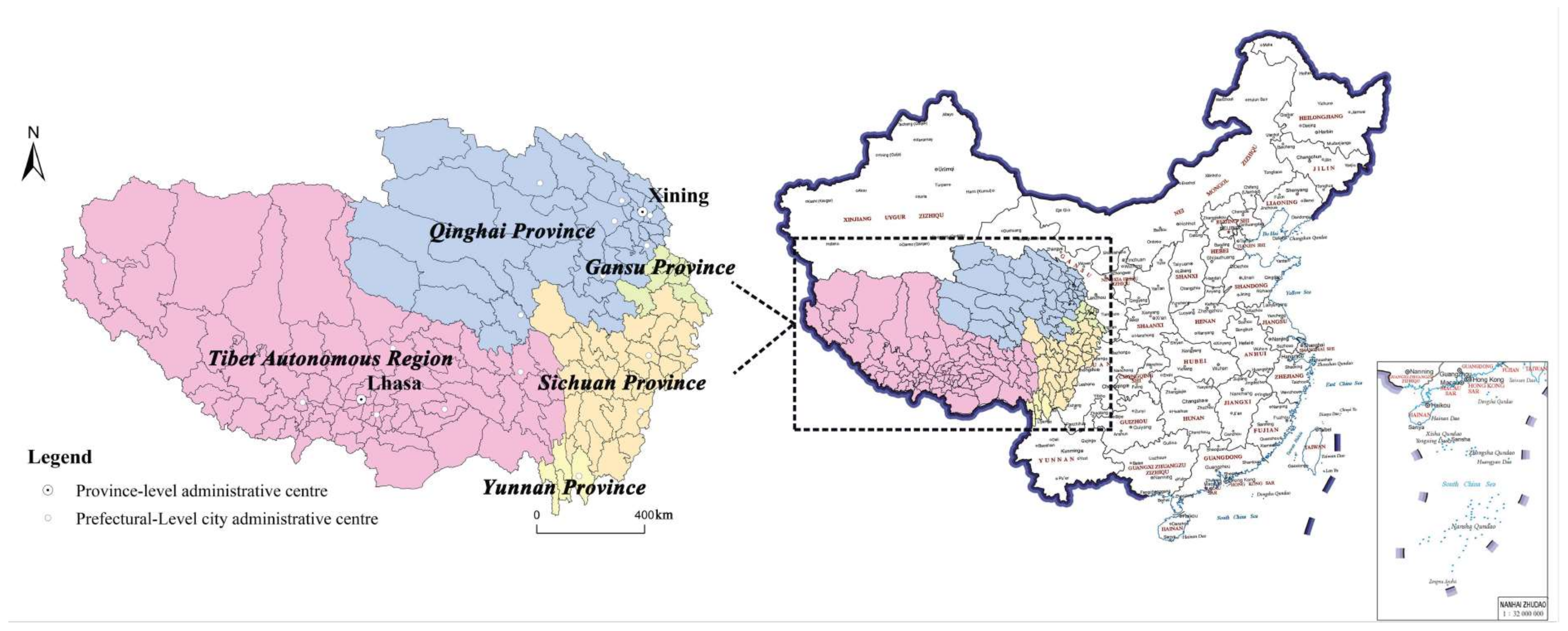
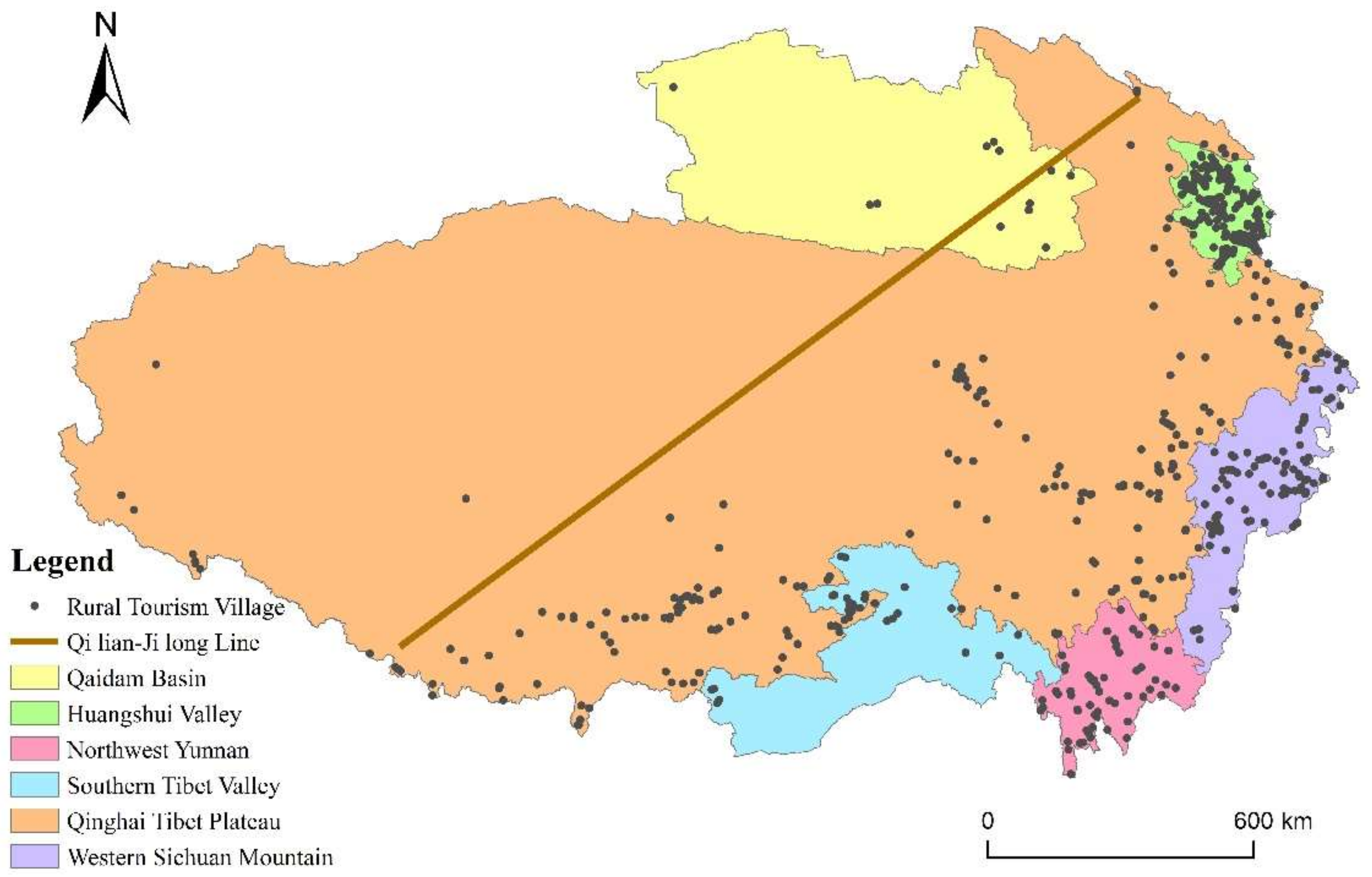
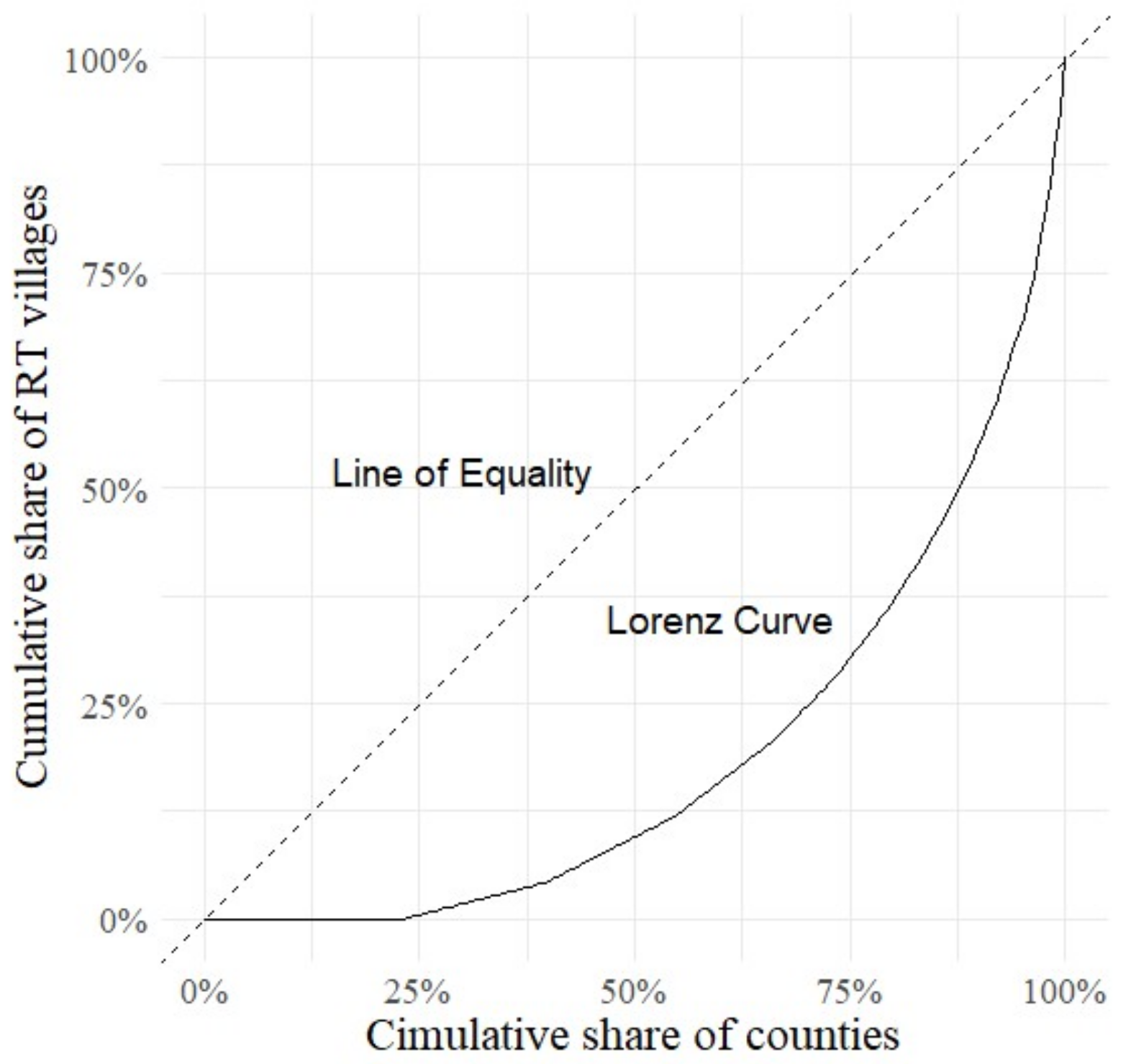
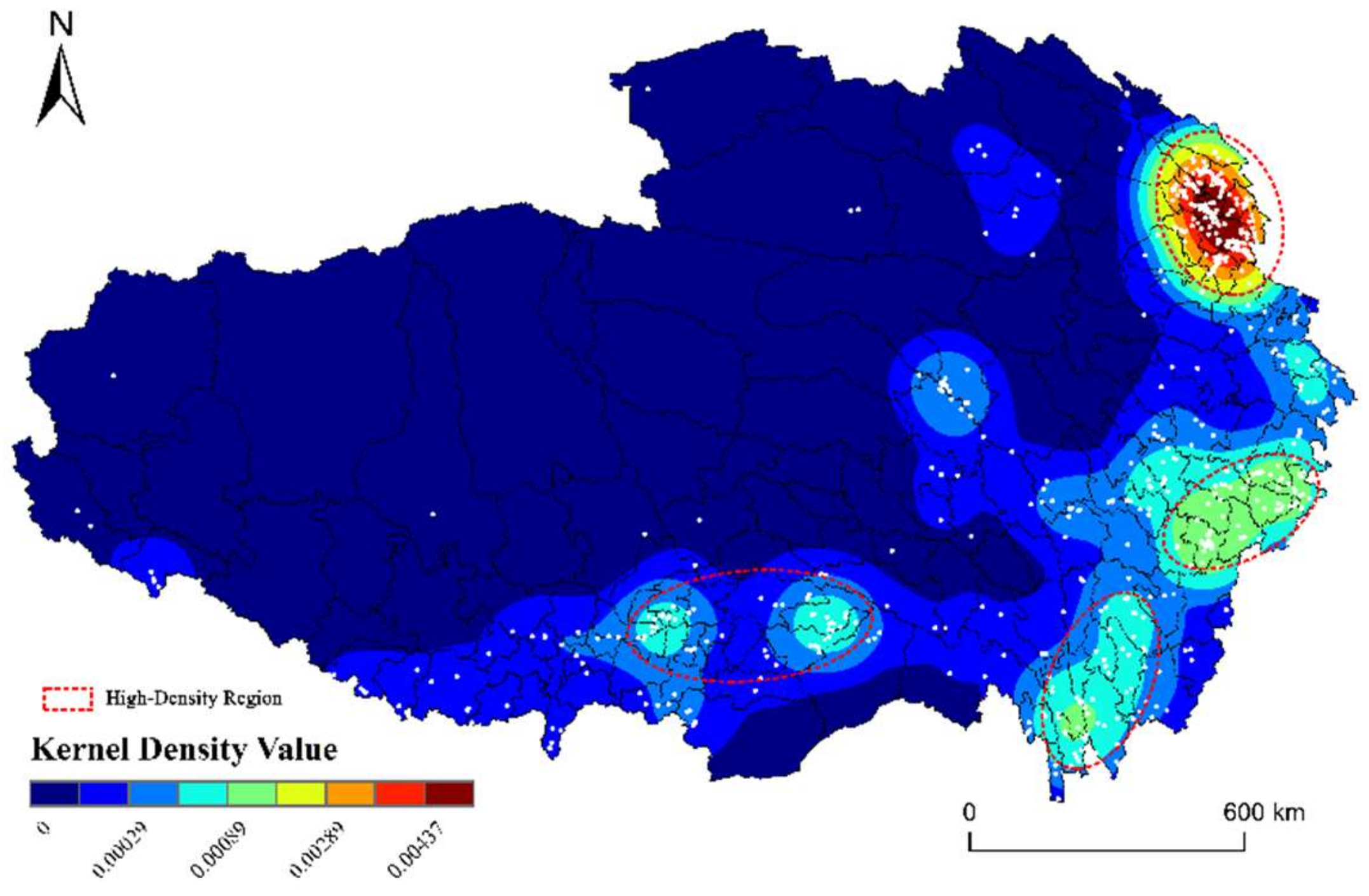
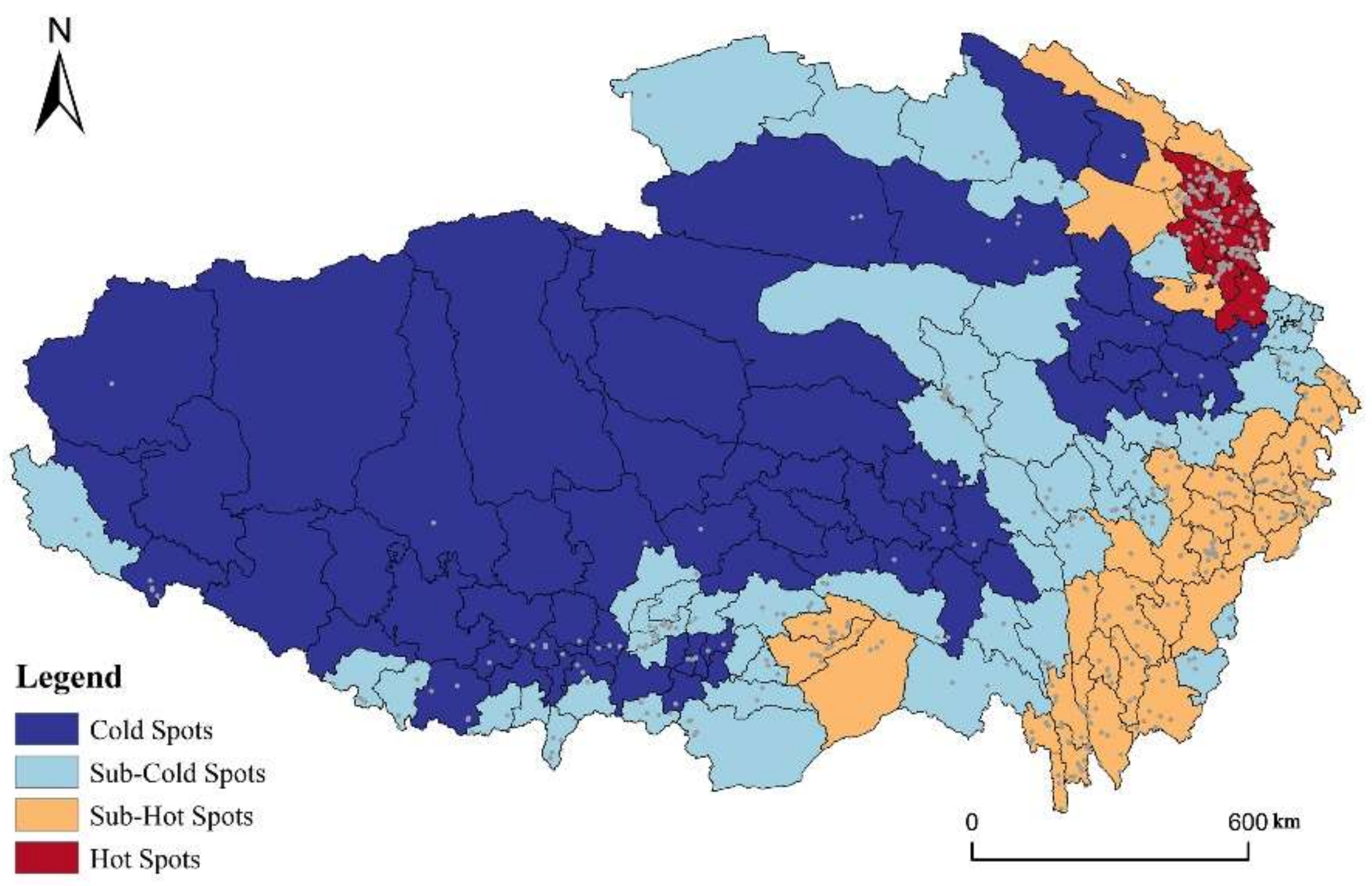
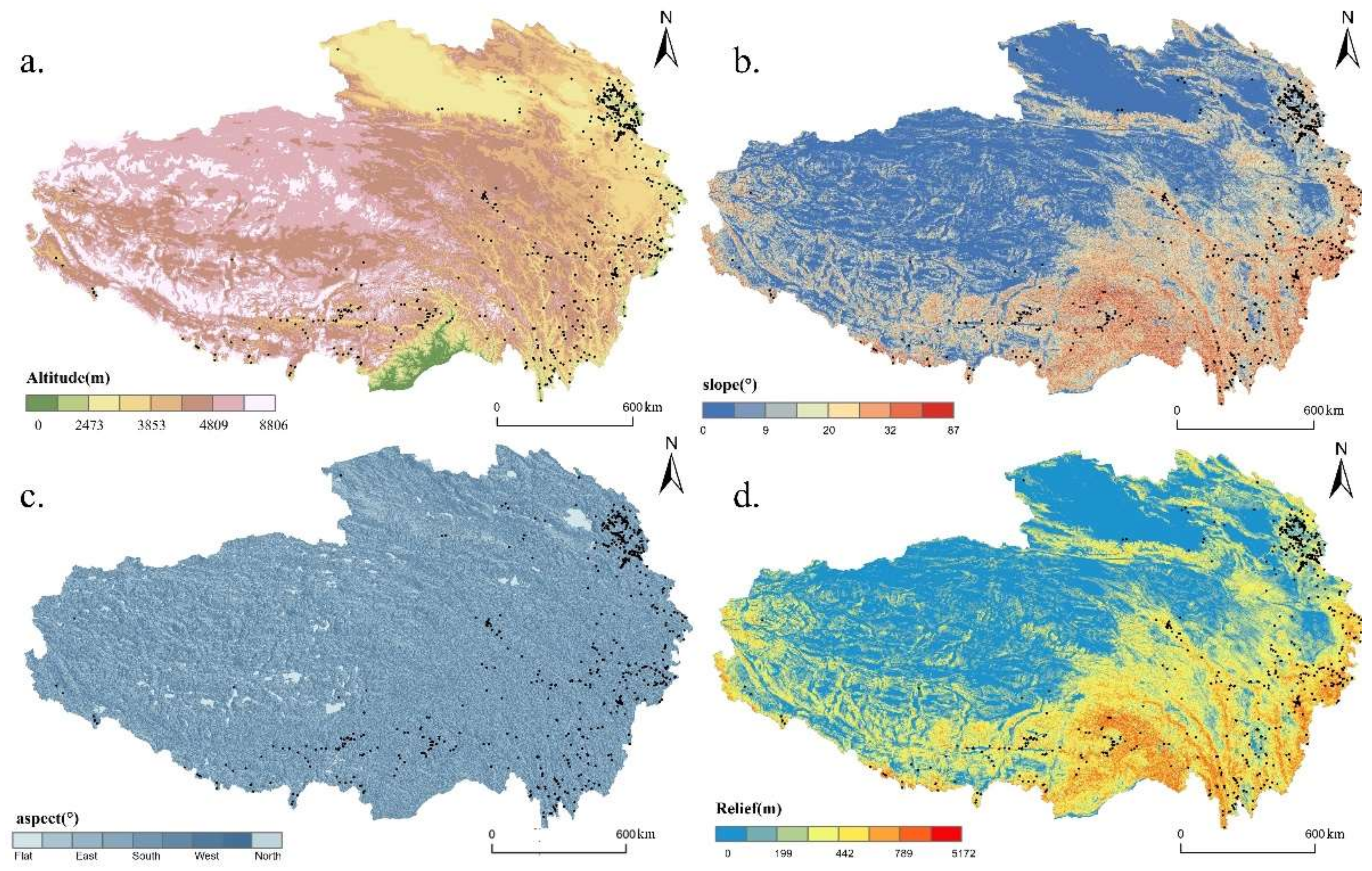






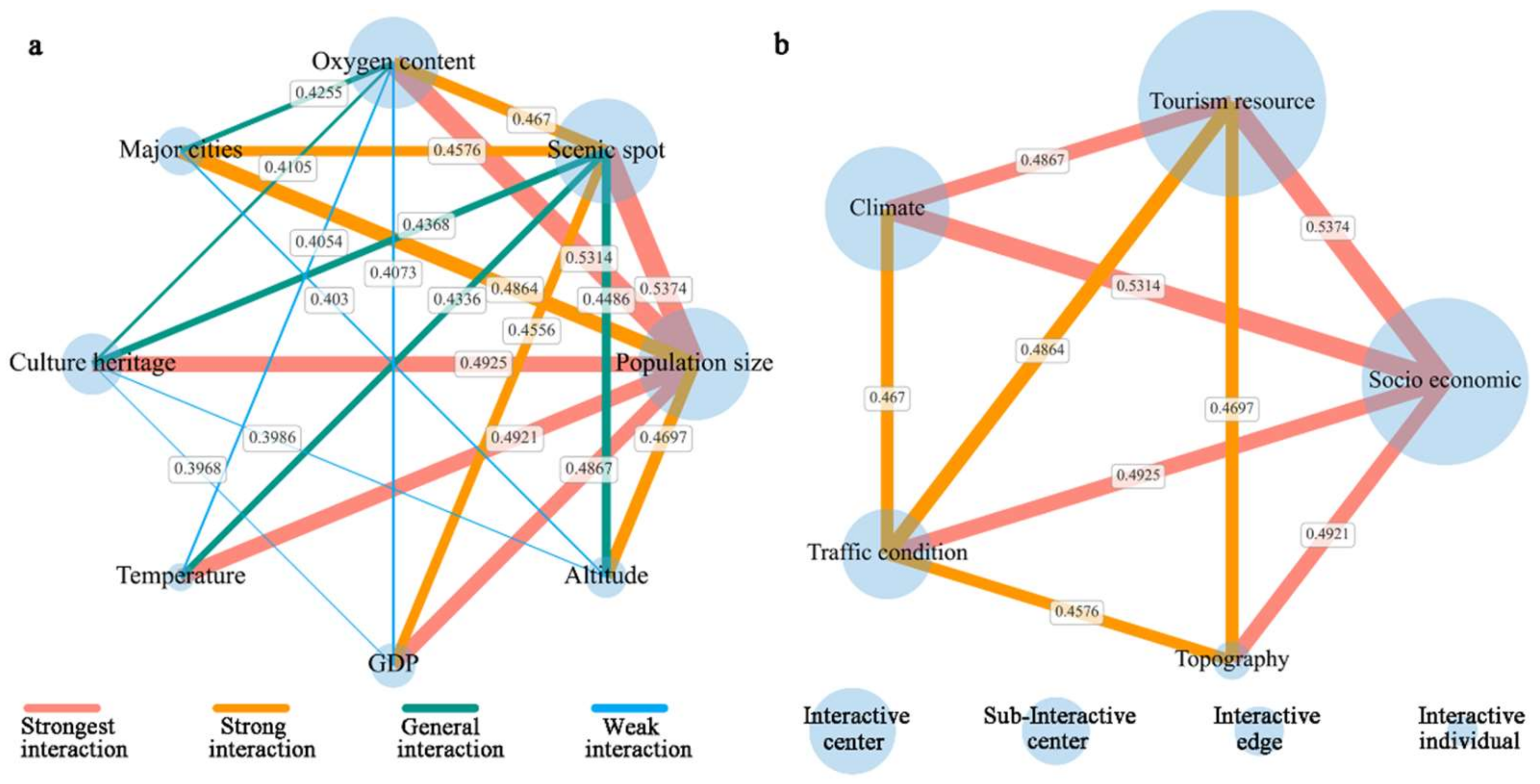
| Influence Factor | Evaluation Index | Geographical Proxy Variables |
|---|---|---|
| Topographic | Altitude | Altitude |
| Slope | Slope | |
| Aspect | Aspect | |
| Relief | Relief | |
| Climate | Temperature | Average annual temperature |
| Oxygen content | Average annual oxygen content | |
| Hydrology | River/Lake | Distance from river/lake |
| Traffic Condition | Transport access | Distance from main roads |
| Distance to source market | Distance from central cities | |
| Socio-economic | Population size | Total population |
| Level of economic development | Gross regional product | |
| Tourism resource | Scenic spot | Distance to high level scenic spots |
| Culture heritage | Distance to culture heritage |
| 10 km | 20 km | 30 km | 40 km | 50 km | |
|---|---|---|---|---|---|
| Highway | 130 | 214 | 255 | 291 | 315 |
| National road | 169 | 224 | 273 | 306 | 342 |
| Provincial road | 262 | 352 | 443 | 489 | 532 |
| All road | 416 | 500 | 563 | 587 | 604 |
| Altitude | Slope | Relief | Temperature | Oxygen Content | River/Lake | |
|---|---|---|---|---|---|---|
| Q-stastic | 0.131 | 0.054 | 0.042 | 0.224 | 0.242 | 0.059 |
| p-value | 0.000 | 0.000 | 0.000 | 0.000 | 0.000 | 0.000 |
| Main Road | Major Cities | Population | GDP | Scenic Spot | Culture Heritage | |
| Q-stastic | 0.092 | 0.237 | 0.333 | 0.176 | 0.332 | 0.237 |
| p-value | 0.000 | 0.000 | 0.000 | 0.000 | 0.000 | 0.000 |
Publisher’s Note: MDPI stays neutral with regard to jurisdictional claims in published maps and institutional affiliations. |
© 2022 by the authors. Licensee MDPI, Basel, Switzerland. This article is an open access article distributed under the terms and conditions of the Creative Commons Attribution (CC BY) license (https://creativecommons.org/licenses/by/4.0/).
Share and Cite
Qi, J.; Lu, Y.; Han, F.; Ma, X.; Yang, Z. Spatial Distribution Characteristics of the Rural Tourism Villages in the Qinghai-Tibetan Plateau and Its Influencing Factors. Int. J. Environ. Res. Public Health 2022, 19, 9330. https://doi.org/10.3390/ijerph19159330
Qi J, Lu Y, Han F, Ma X, Yang Z. Spatial Distribution Characteristics of the Rural Tourism Villages in the Qinghai-Tibetan Plateau and Its Influencing Factors. International Journal of Environmental Research and Public Health. 2022; 19(15):9330. https://doi.org/10.3390/ijerph19159330
Chicago/Turabian StyleQi, Jianwei, Yayan Lu, Fang Han, Xuankai Ma, and Zhaoping Yang. 2022. "Spatial Distribution Characteristics of the Rural Tourism Villages in the Qinghai-Tibetan Plateau and Its Influencing Factors" International Journal of Environmental Research and Public Health 19, no. 15: 9330. https://doi.org/10.3390/ijerph19159330
APA StyleQi, J., Lu, Y., Han, F., Ma, X., & Yang, Z. (2022). Spatial Distribution Characteristics of the Rural Tourism Villages in the Qinghai-Tibetan Plateau and Its Influencing Factors. International Journal of Environmental Research and Public Health, 19(15), 9330. https://doi.org/10.3390/ijerph19159330






